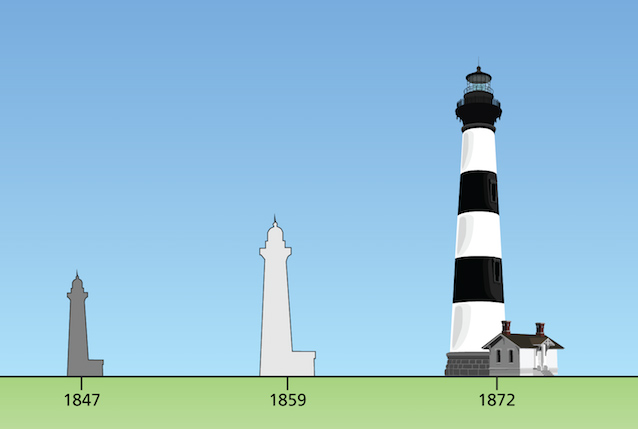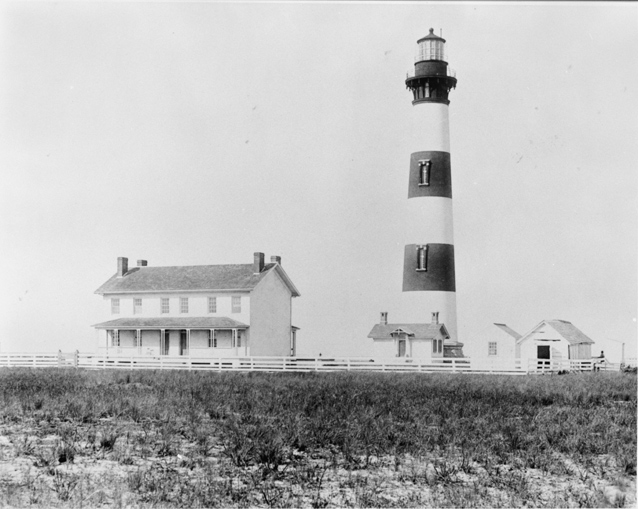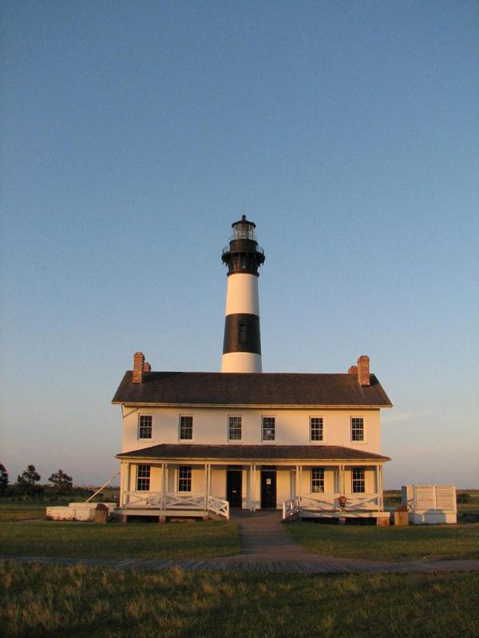There is no part of the Coast of the US which requires a Light House more than Body’s Island- ’tis in the direct route of all going North or South & of all foreign vessel bound into the Chesapeake... Thomas H. Blount, Collector of Customs, 1843

National Park Service
The First Light
Prompted by an increase in shipping along the east coast of the United States in the early 1800s, and the Outer Banks becoming increasingly known as the “Graveyard of the Atlantic”, the Department of the Treasury’s US Lighthouse Establishment Program authorized the creation of three lighthouses on the southern portion of the Outer Banks, neglecting the coastline north of Cape Hatteras. To fulfill the need for a lighthouse north of the Cape, on March 3, 1837 Congress approved a $5000 budget to construct a lighthouse at Bodie Island.
Bureaucracy, insufficient funding, and complex land transactions delayed the construction of the lighthouse for over ten years, with the lighthouse not officially opening until the spring of 1848. The entire light station, built on what would soon prove to be an inadequate layer of mud and sand, consisted of a 54-foot brick tower on the southern end of Oregon Inlet, an unpainted wood single dwelling, a 2000-gallon brick cistern, and two privies.
By 1850, the lighthouse’s foundation began to sink, causing the tower to lean eastward. By 1858, the foundation was beyond repair and the original tower was abandoned and demolished.
Specifications
Height- 54 feet
Material- brick
Lens- 14 Argand lamps, total lens diameter of 10 feet with flashing signal (a fourth-order Fresnel lens replaced the Argand lamps in 1854 with a fixed white light, varied by red and white flashes)
Construction completed- 1848
The Second Light
In 1858, Congress approved $25000 to build a new lighthouse with a third order Fresnel lens, a significant upgrade from the original tower. In order to avoid the fate of the first Bodie Island Lighthouse, the second was constructed on a stone foundation resting on piles. Standing 80 feet tall, the second Bodie Island Lighthouse was completed in 1859; its new Fresnel lens could be seen at a distance of 15 miles. This new lens required two operators, necessitating the construction of a new dwelling for the assistant keeper.
At the onset of the Civil War, the Outer Banks was noted for its strategic importance to both the Union and Confederacy. In May 1861, Confederate forces built a series of forts along the coast to protect the inlets and sounds. As Union troops began to seize the forts, the Confederates destroyed the Bodie Island Lighthouse to prevent Union troops from using it as a lookout. For the duration of the war, the coastline from Cape Henry, VA to Cape Hatteras, NC, 120 miles long, was without navigational aid.
Specifications
Height- 80 feet
Material- brick
Lens- revolving third-order Fresnel lens, flashing every 90 seconds
Construction completed- 1859

Library of Congress
The Third Light
The third Bodie Island Lighthouse was sited one-and-one-half miles north of the two previous locations, due to the constant movement of Oregon Inlet. The US government acquired 15 acres of land from John B. Etheridge (coincidentally a former keeper of the first Bodie Island Lighthouse) on which to construct the new light station on June 13, 1871. Before construction on the tower could begin, construction commenced on temporary dwellings for workers and materials.
The sturdiest construction yet of the three towers, the foundation consisted of a wood grillage laid at the bottom of a seven foot pit, upon which large granite blocks were laid. Courses of rubble block grouted with cement raised the foundation an additional five feet. On this foundation was placed the base of the tower, consisting of cut granite on the outside and rubble set cement on the inside.
156 feet tall with a first-order Fresnel lens exceeding an 18 mile range, the third Bodie Island Lighthouse exhibited its light for the first time on October 1, 1872, operating under a series of primary and assistant keepers for decades.
In 1939, the US Coast Guard took over operation of the Bodie Island Lighthouse; the following year, the final two keepers were replaced with an electric generator on a timer. During World War II the US Navy used the tower as a lookout for German U-Boats.
On October 15, 1953, the US Coast Guard declared the 56 plus-acre Bodie Island Light Station property surplus and transferred it to the National Park Service as part of Cape Hatteras National Seashore; the Coast Guard maintained jurisdiction over the tower itself until July 13, 2000, when it too was transferred to the National Park Service.
From 2009 to 2012, the tower underwent extensive rehabilitation, officially opening for climbing in 2013. It remains a functioning navigational aid to this day.
Specifications
Height- 156 feet
Stair steps- 214
Material- brick, cast iron, granite, copper, wood, bronze
Lens- first-order Fresnel lens, manufactured by Barbier and Fenestre in Paris, France, 1871 (lighting materials and methods have evolved over time from lard oil to electricity; current light pattern is 2.5 seconds on, 2.5 seconds off, 2.5 seconds on, 22.5 seconds off)
Construction completed- 1872

National Park Service
Last updated: September 28, 2016
